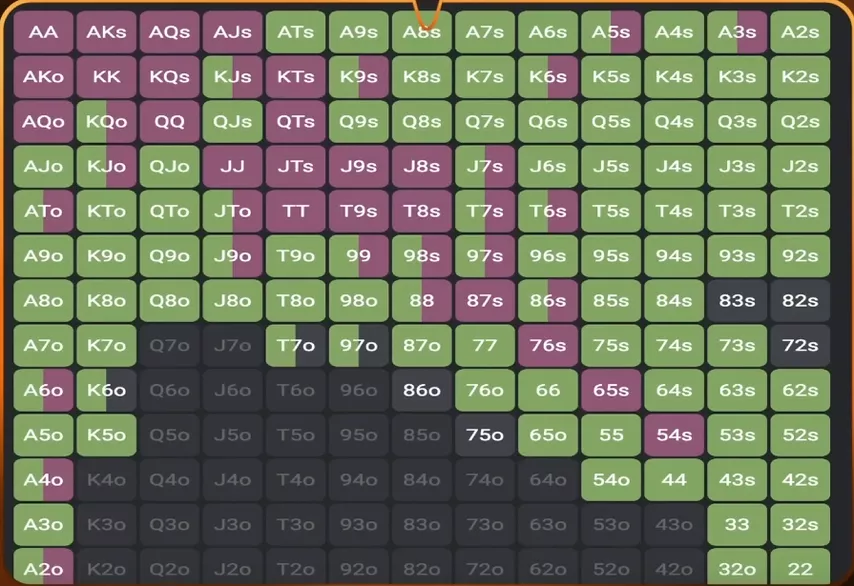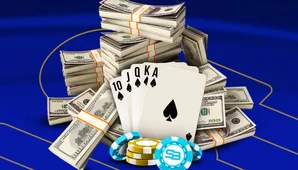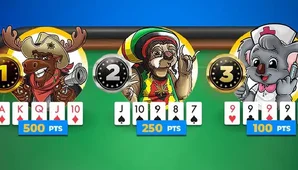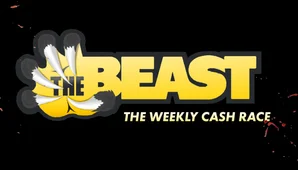Pete: We are here today because although we have a lot of dissimilarities – Mark, you are mainly geared towards live poker, and I'm geared towards online – we have a lot in common as well. We talk about cash game poker, we're both proponents of this anti-copying GTO movement, the idea that the best true EV line, as I would call it (maybe you would just say the best line), is the result of exploiting and your opponent's range and hand reading and stuff like that.
You have brought five spots where you think theory doesn't matter, correct?
Mark: Correct, and to be clear, these are spots where I think Theory at equilibrium doesn't matter. I always think Theory matters because the best exploit player in the world, if you tell it how somebody's playing, is going to be a solver.
A lot of people think like, "Oh, you're anti-solver, you're anti-GTO." That's not the case at all. I've probably got carpal tunnel from spending so much time in PioSolver. But I just think people misapply theory and try to use it at equilibrium against a player. They're looking at a guy in seat 8, Big Jeremy, who's on his eighth beer, and they're thinking, "Well, am I balanced in this spot?" And that's just absolutely insane to me.
Pete: Yeah, you know, I agree. I think the terms Theory and GTO are kind of used interchangeably at times, and that's not the case at all.
1. Polar 3-Bets From the Big Blind
Raise 2.5 BB from the button, we have on BB.

In equilibrium at 100 big blinds deep, this hand is actually supposed to be a polar three-bet. Meaning you can pull up a polar range here in equilibrium. What we're supposed to be doing is three-betting a ton of kind of just polar bluffs.

We're not going pure pure linear, right? We have hands like Jack-8 suited, 10-6 suited, 10-7 suited, we have like A-6 off, A-4 off. So we have a ton of just like kind of polar bluffs here.
What I wanted to show is if the only thing we do here is adjust and we reduce the in-position player having four-bets by 3% and we reduce the amount he folds by 3% – which I think even solid online regs are probably not finding enough four-bets, they're calling just a little bit too much in position – all of a sudden our range from the big blind just becomes almost pure pure pure linear here.
And all the kind of four-bet bluffs get immediately just taken out of our range from the big blind.

You see it's just all the good hands. We no longer have that 10-7 suited in there. So I would just say like against most players, unless you're playing against like a top top reg at 1k/NL or 2k/NL or whatever, I would just recommend not three-betting polar from out of position.
2. Skipping C-Bets on Low Boards
So we're going to a flop here, and this is point number two. This is just range betting on boards that are quote-unquote "bad for us". I would say against strong players, against very very strong players, this does not apply.
But be careful as to who you ascribe the tag of strong player to.

In equilibrium, we're supposed to bet with our range 35% of the time here. But the questions I would ask are:
- What if the opponent is fast-playing too much of their value on this flop and not protecting their calling range?
- What if the opponent is over-folding to a c-bet?
- What if the opponent is over-defending with weak marginal hands?
- What if the opponent is under-bluffing when we check back?
If one, two, three, or four of those things start to be true, then all of a sudden, the solver on this flop will just immediately begin range betting.
Range betting here seems to be pretty good against weak players. The thing that range betting allows you to do is when they raise off their strong stuff, well, you can just immediately fold. And when they call, well now they're going to be extremely capped because on these wet, dynamic boards, they're just so incentivized to raise off their two pair, their sets, their straights right away.
Getting to the turn, they just have too much weak stuff. And when you have a hand that is air (not like , maybe a weaker hand here), you just know that you are bluffing into an extremely capped range, which makes your bluff much more profitable across turns and rivers.
And when you do have a hand with some showdown value like Ace-Queen here, you can just check back and oftentimes just bluff-catch rivers with ace-high because they raise off so much of their strong stuff on the flop. All of a sudden, you have extremely profitable bluff-catch spots across rivers.



3. Small Draws In Position on the River
The third spot where I believe Theory doesn't matter is small bets in position on the river. Let's walk through this hand:
The cutoff opens, we 3-bet on the button. Flop comes , he checks, we c-bet 1/3 pot, and he calls

Turn is a blank, we continue for a large size, and they call again. River pairs the bottom card, and they check.

In equilibrium, there are no small bets in position on the river. The reason is that you open yourself up to being bluffed. Even when you're going thin on rivers, you generally use bigger than half-pot sizes in theory.
But I want to talk about why small bets in position on rivers can apply against certain types of players:
Against passive players who under-bluff and call too much (typical weak players), a small size for thin value here can be really good. They're never going to blow you off your equity, and you're forcing them to do exactly what you want when they have hands like or .
Now if you are against a player who's just going to spaz and just going to raise a ton whenever they see this small size in position on the river, they're super super aggro, they're going to start turning into a bluff here, they're going to start turning basically everything into a bluff here, then against those type of players, sometimes using this small size with thick value here on the river to induce with over pairs with + on this river and just calling off.
And the point is in general that the small size I think has its place on the river. People don't study how to respond to this small size. Even good players just don't know how much they should be defending, how much they should be raising. And I think against both weak players and against pretty competent players, this small size on the river does have its place.
Pete: Yeah, I think it can also have its place as a bluff because some of the data from Grade of the Car Poker School is that big big small is actually one of the most like overfolded lines ever. It's really, really under-bluffed actually. If the pool ever does that to you, like they go big big and then small, their bluff frequency is like even lower than what the bluff-to-value ratio is meant to be for those pot odds. But when we actually see people react to that sizing, they're folding a lot more than they should be to like should be being in inverted commas there to hit MDF.
So yeah, a lot of cool exploitative stuff going on here. I do think that these are like some of the rules that solvers give us that are once we understand why the solver plays in a certain way, we can see the conditions that would have to be true for that to just fall apart entirely logically. And yeah, as you say, if they're just playing straightforwardly, we think we've got enough equity to value bet small but not big, we want to do this.
The other cool point here is that you're actually investing a similar amount of money to a solver in this hand because your flop strategy is very similar.
Mark: Yeah, and I really like what you said about the big big small line as a bluff. I think that's really, really effective against weaker players who are very much addicted to just like fast playing their value because they don't want a bad beat. And a lot of those players also are just like very, very sticky even to big bets on turns with their draws, so they're just never folding a hand like on the turn or like or of on the turn. And if you get to this river with just complete air with high or high or something like that, well now all of a sudden you have a very profitable bluff spot to just get them to fold like their and and and stuff like that on the river.
Where you can just go big big small. I mean, if you think the player's never folding a , well suddenly you just have a print bluff like you said by going big-big-small here.
4. Defending Out of Position Check Range on the River
All right, so this is protecting our check range out of position on the river.
So in this one, the button opens, and we three-bet in the small blind with , he calls. Flop is , we c-bet, button calls. Turn is a blank, we continue, button calls. And the river is another blank here.

And on this river, the solver pure checks top two pair here from out of position.
And the thing I want to talk about, if our opponent under-bluffs even by a small percentage on the river, we're no longer incentivized to protect our checking range from out of position here. Like they're supposed to bluff pure with all of the that gets here, all of the , the , the , , , . And if they just start checking back any of those combos here on the river, we're just super-super incentivized to just bet ourselves with our value hand because they're just not bluffing enough when we check to them.
Now a lot of people may be thinking, "Okay, so maybe they're under-bluffing, but what if they're also over-folding?" Well, in that particular scenario, we are just incentivized to size down. Then we don't have to always just go all-in here, and we can size down. The adjustment here isn't to check if they're over-folding, it's to use smaller sizes.
Pete: Yeah, trying to find the sizing they over-fold to the least, I guess, is what we're trying to do.
5. Refusing to Bluff Because of "Bad" Blockers
So this is going to be cutoff opens, we three-bet on the button, and cutoff is going to call. Flop comes , .
A lot of people say this is one of the best flops in all of poker, the . I don't know if you've heard that before, but it is maybe the best flop in all poker.
Cutoff checks, we c-bet, he calls. Turn is a blank, he checks, we bet, he calls. And the river is a blank and he checks again.

Now I want to talk about giving up with bad blockers on the river and why in a lot of spots, particularly against players who are not super strong players, it may not matter. Now in theory, they're supposed to get to this river with a ton of , some , and some suited. If they raise off too much of their strong stuff on the flop and call with too much of their weak stuff, which I'd say almost every try-hard recreational player, even bad regs are doing, what that means is getting to the river, they just don't have a very strong range.
Now getting to this river, we've already eliminated that they're probably not going to have , , and suited as much as they should. If they're supposed to call on this river when we jam 25% of the time, if they over-fold just slightly, or they're supposed to call top pair on this river – they're supposed to call with 95% of the time on this river – if they ever fold here or they ever fold here on this river, even though won't win as much money as hands that are blocking their calls and unblocking their folds, hands like or or something like that, going all-in with here against people that just don't get to the river with a strong enough range is still outperforming giving up.
Now it's not going to perform as well as a hand like going all-in, but it's still going to outperform the EV of just checking back and giving up. Now in theory, in equilibrium, jamming on this river is losing money, but if you start to just make a few assumptions, it can very quickly become positive EV.
That's why I get so frustrated when people say, "Well, you know, I just have a bad hand to bluff" without even taking that extra step to think, "Well, is my opponent calling enough? Does my opponent have more of a capped range than I think?" Without even asking those additional questions, which I think are super, super important.
Pete: Yeah, I call this the "better bluffs fallacy" where the student will be like, "We have better hands to bluff. I'd rather have..." It's like, yeah, well, you know, I would rather have some coffee still in this cup 'cause I want more coffee. That doesn't mean I'm not going to drink the water that's beside me because I'm thirsty. I'm still going to drink the water regardless of whether there's coffee in the cup. I'm not going to be like, "I'm not drinking that water 'cause I'd rather have coffee." Like, it's nonsense.
This is what people do instead of comparing the EV of the two choices on the table, which are bluff or don't bluff. They compare a real situation to a situation that isn't actually happening, and that to me can never tell you what to do in the real situation. It can't tell you what's highest EV. It can tell you how to build this... I'd call it main character syndrome, the self-obsessed inward myopic view of your own strategy where all you care about is constructing your own range and placing this block here and this block there, as if to say that that's somehow going to magically, causally give you all the EV on the planet. It's not.
Mark: I hear people say this type of stuff all the time like, "I 3x potted a river against a friendly European pro and he goes, 'Oh, that's too greedy. If you just would have bet pot, I would have called.'" I think, "Yes.. exactly."
Pete: Yeah, people like to make big assumptions. They've got their own game down and it might even be that that European pro is playing well against the average reg, but you know, that's why we need to be the wolf in sheep's clothing. That's why we always want to be a step ahead.So I think this is a wonderful example of like my rule, which is like when they need to call all top pair, it will be over-folded, and when they need to start folding over pair, top pair, two pair a lot, it'll probably be under-folded.
Humans are instinctive beasts, you know. We are drawn to absolute hand strength whether we like it or not.













